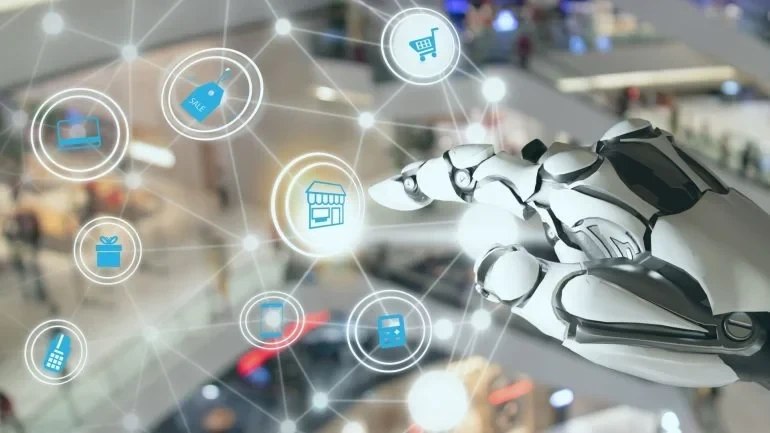As consumer expectations continue to evolve in today’s digital age, retailers are compelled to reimagine the shopping experience.

Consumers are accustomed to a digital world filled with mobile games, social media, and immersive entertainment experiences on smartphones tablets and larger screens. This enriched landscape has ultimately heightened expectations in retail environments. It is a shift which presents both a challenge and an opportunity for businesses to innovate and meet these new standards in consumer engagement, both in-store and online.
Retailers must adapt to this digital-centric consumer behaviour, leveraging technology to enhance the shopping experience in physical stores, online platforms and in the integration of both.
Integrating digital engagement from personal devices to retail environments
For retail businesses, navigating the shift from mere engagement through personal devices, to crafting captivating in-store customer experiences, is imperative.
Traditional retail strategies, such as static displays and repetitive advertising, whether found on the shopfloor or outside, are no longer effective in capturing the attention of consumers. Holographic solutions and 3D imagery are also setting new standards for viewer immersion. This change in consumer behaviour necessitates a transformation in how retailers approach customer interaction in their physical stores.
Retail leaders must recognise and respond to this evolution. Keeping pace with rapidly changing customer preferences goes beyond simply following technological trends; it involves a strategic overhaul of how retailers engage with customers in their physical spaces. This means integrating interactive technologies, personalising shopping experiences, and creating dynamic, engaging environments that reflect the convenience that customers experience with their personal devices.
The move towards ‘phygital’ experiences
In the retail sector, the ‘phygital’ experience, which merges physical and digital elements, is becoming essential for customer engagement.
For example, new Marks & Spencer stores in the UK now feature digital ordering systems on the shop floor, where customers can place orders in seconds via their smartphone or with the available digital kiosks.
More retailers are searching for the right interactive digital features to be integrated into their physical stores. The recent holiday season saw retailers getting into the festive spirit with the deployment of Christmas-themed holographic solutions, from store windows to within the shopping space itself.
New arrivals can also be digitally showcased to passers-by. Within a store itself, consider the potential of augmented reality (AR) mirrors in clothing stores, enabling customers to try on outfits virtually, saving time and encouraging a quick purchasing decision. A holographic entity can welcome shoppers to stores and demonstrate products and services.
These advancements represent a significant shift in retail, where the blending of digital and physical experiences enhances customer interaction.
New technologies in customer interactions
In the retail industry, AI can transform customer service. Frequently found in online shopping via chatbots and virtual assistants, AI is poised to make a significant impact in physical retail spaces. Personalised product recommendations and virtual try-ons can elevate the customer experience.
AI-powered holographic chatbots are even a reality today. They can be placed in key areas of a retail store or a public space. They can ensure inclusivity for customers from different backgrounds by interacting in several languages to communicate essential information.
By bringing these capabilities on to the shop floor, customers can ask questions and receive answers in the same way they would online, enabling an omni-channel approach. This enables clarity for the customer and cuts costs associated with educating staff to deal with in-store queries.
Advantages of digital integration
From a retail standpoint, the benefits of incorporating digital technology into customer experiences are substantial, especially for high-end retailers. Luxury goods can be showcased in high-quality 3D models powered by holographic technology, facilitating an interactive and dynamic viewing experience for customers.
Expensive items bring the risk of security worries, but this way, customers can engage in a virtual environment that closely mimics the experience of physically examining them. Smaller items, such as rings or watches, can be represented in a much bigger size, so customers have the opportunity to appreciate the finer details of products in a safer and more accessible way.
Retail space can come at a premium, and the space-saving benefits of digital displays can be game-changing.
Businesses can create more open, welcoming shopping environments by removing the unnecessary clutter created by large physical displays. Such a shift aids in fostering an interactive and engaging atmosphere, where customers are encouraged to discover and engage with products through novel, tech-enhanced methods.
New methods allow for the shopping experience to remain continually fresh and appealing, drawing customers back for more.
Meeting green retail policies
Integrating digital technologies in customer experiences not only elevates engagement, but underscores retailers’ sustainability commitments.
By transitioning from traditional print to digital mediums, retailers can significantly reduce their environmental footprint. Digital solutions offer the added benefit of agility in content management, minimising the need for physical updates and their associated waste, whilst keeping pace with dynamic market trends and stringent environmental standards.
Building emotional relationships with retail customers
In the retail sector, the impact of immersive digital experiences extends beyond just practical advantages; they play a crucial role in forging emotional connections with customers, which is key for cultivating loyalty and repeat purchases. When a customer has an engaging and memorable experience, they are more likely to become repeat customers, or even advocates of the brand.
It’s imperative for retail businesses to adapt their customer engagement strategies as expectations shift. More than just a fad, immersive and interactive customer experiences are a strategic must-have in a digital world.
By seamlessly integrating digital innovations into physical retail spaces, businesses can create captivating and memorable experiences that resonate deeply with customers. These experiences do more than complete a sale; they create emotional bonds, foster brand loyalty, and differentiate businesses in a competitive marketplace. Deploying digital solutions can meet customer demands and lay the groundwork for innovation in the long-term.
About the author: Kiryl Chykeyuk is the CEO and co-founder of HYPERVSN, an Integrated 3D holographic display system for creating and presenting personalised 3D content.
Source from Retail Insight Network
Disclaimer: The information set forth above is provided by retail-insight-network.com independently of Alibaba.com. Alibaba.com makes no representation and warranties as to the quality and reliability of the seller and products.




